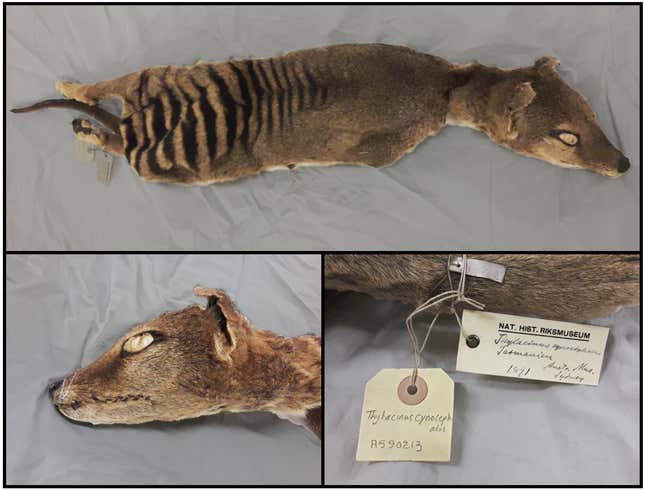The last known thylacine—the largest marsupial carnivore in recent times—died in Tasmania’s Beaumaris Zoo in 1936. But the animal has recently been the target of de-extinction efforts, and now, a team of researchers has managed to recover RNA from the creature—the first time such a feat has been accomplished for any extinct species.
The researchers extracted, sequenced, and analyzed RNA (Ribonucleic acid) from an approximately 130-year-old thylacine (Thylacinus cynocephalus) specimen in the Stockholm Natural History Museum. The team’s research describing the recovery and its utility was published today in Genome Research.
Advertisement
“Our study is unique in this sense as we were able, for the first time, to sequence RNAs from an extinct species, the Tasmanian tiger,” said Emilio Mármol-Sánchez, a paleogeneticist at Stockholm University and the Centre for Paleogenetics in Stockholm, and the study’s lead author, in an email to Gizmodo. “This is the first time that we have been able to catch a glimpse of the actual biology and metabolism of Tasmanian tiger cells right before they died.”

Advertisement
Advertisement
Like DNA, RNA is a molecular structure made up of nucleotides. RNA is single stranded, and is used in protein synthesis and carries genetic material in some viruses. In the recent study, the researchers identified RNA from the desiccated thylacine specimen’s skin and skeletal muscle tissues that coded proteins.
The thylacine—also called the Tasmanian tiger or the marsupial wolf—was a carnivorous marsupial endemic to Tasmania and, in the more ancient past, Australia. It was overhunted in Tasmania during the late 19th and early 20th centuries, after being blamed by the Tasmanian government for the killing of livestock. The animal was also pushed to extinction by habitat loss and introduced diseases, according to the National Museum of Australia.
Recently, the ‘de-extinction’ company Colossal Biosciences stated it would attempt to produce a proxy species to the thylacine and introduce it to the forests of Tasmania, which the species inhabited a century ago. Colossal also says it has plans to create proxy species of the woolly mammoth and the dodo bird, iconic extinct species that disappeared some 4,000 years ago and about 350 years ago, respectively.
But all the talk of de-extinction is merely the backdrop of the recent team’s RNA research, not its aim. “Resurrecting the Tasmanian tiger, or otherwise said, its de-extinction, was not and is not the focus of our research,” Mármol-Sánchez said. However, he added, “All the scientific developments required for resurrecting or recreating extinct species back to life will for sure benefit science and society in general, from gene editing technology, to in vitro fertilization or computational tools needed to analyze the data.”
Advertisement
The thylacine was considered a good proof-of-concept target for the team, an idea that clearly paid off given the results. But researchers’ understanding of extinct and extant viruses could also benefit from this type of RNA recovery.
“In the future, we may be able to recover RNA not only from extinct animals, but also RNA virus genomes such as SARS-CoV2 and their evolutionary precursors from the skins of bats and other host organisms held in museum collections”, said Love Dalén, an evolutionary geneticist at Stockholm University and the Centre for Paleogenetics, in a university release.
Advertisement
With the number of extinct creatures that sit in museums, RNA recovery from other species may soon follow that of the thylacine. Old DNA studies have come a long way in recent years—both in animals but also in human population studies—and similarly antique RNA studies may soon follow.
More: Building Blocks of RNA Spotted at the Center of the Milky Way
Services Marketplace – Listings, Bookings & Reviews